
Medically Important Species
I hope to cover here some of the most commonly quoted venomous species. A few others are dangerous as well but really is beyond the scope here to cover. All pictures are on this page for purpose of comparative study.
* not considered dangerous currently.
Fattailed
scorpion Androctonus australis
Picture of Androctonus australis, courtesy of Gordon W.
This is truly a very dangerous scorpion. Numerous deaths in Middle East countries and North Africa are attributed to it though again children and elderly are more at risk. It is not native to Asia (except perhaps India) and America. It is also known to be quite aggressive.
GENERAL IDENTIFICATION: (not meant to ID the species)
It can grow to 4 or 10cm (Dave Gaban) and is generally yellow in colour. The
telson,metasoma V and distal part of metasoma IV is usually darker. It has slender
pedipalp typical of Buthidae. Its metasoma is thick and is widest at metasoma III and IV.
On metasoma III to V, a very deep concavity is observed. There are few hairs on the
metasoma and the telson. Outer tooth of basitarsal spur bifurcates at base of walking
legs.
Three subspecies exist. Androctonus australis australis: Yellow overall. A.australis
lybicus: Black at distal metasoma and telson. A.australis hector: brown at
distal metasoma and telson.
LD50 (mg/kg of lab mice, subcutaneous): range from 0.3 -
0.7(different reference quote different range or value)
All LD50 below will follow same parameters unless otherwise stated.
Death stalker, Leiurusquinquestriatus
Leiurus quinquestriatus courtesy of Gordon W. (Sweden)
Another very dangerous scorpion. It is known to occur quite commonly in deserts of
North Africa and South West Africa.
It has one of the highest potency among scorpions to mice.
GENERAL IDENTIFICATION:
The only ID I have is the picture. Look out for the very slender pedipalp and body
coloration and pattern. I do not know the size attainable as well.
LD50: 0.16- 0.50 mg/kg
Yellow scorpion, Tityus
serrulatus
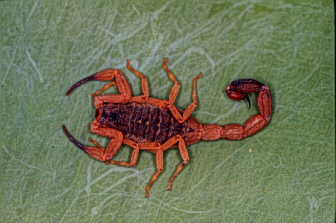
Tityus serrulatus courtesy of CEVAP.
A Brazilian scorpion which is extensively studied by CEVAP. Even though there are few documented deaths (death mainly comes from children under 7), the symptoms is severe and among 5% of the patients studied by R.M.Lira-da-Silva and his co workers, there is systemic involvement. This represents a very significant percentage.
GENERAL ID:
A sad case in point is that I do not have the ID but base it largely on the ID of
others.Will appreciate if anyone has the information. Till then let the photo speak for
itself.
LD50: 0.43-1.45 (0.43 given by Simard and Watt, 1984) (1.45 by Habermehl 1981)
Fattailed scorpion, Androctonus crassicauda
Photo of Androctonus crassicauda, courtesy of David Gaban
This is another dangerous scorpion found more commonly in SouthWest Asia.
The following information is interpreted from Dave Gaban :
Several coloration of A.crassicauda exists. It ranges from olive-brown to reddish
brown to black (there's a picture in 'Tarantula and Scorpions' by TFH which misID a black A.crassicauda
as A.bicolor. Rare isolated geographic race is found to be yellowish colored. Even
though morphologically, some yellow strains look like A.australis, they do not have
the dark distal metasoma (metasoma IV and V), telson and aculeus (sting). It is more
easily confused with A.bicolor but it has a comparatively more bulbous pedipalp.
However, compared to A.australis, its pedialp is more slender.
LD50: 0.08- 0.5 (Simard and Watt: 0.4)
Judging by its potency, it is one of the very dangerous species though I do not have a
death stats on it.
Black fat tail scorpion, Androctonus bicolor

Androctonus bicolor, courtesy of Dave Gaban
Not all deadly scorpions are shades of yellow. A.bicolor is black and again note the
extraordinarily slender pedipalp and thick metasoma. This is quite often confused with Androctonuscrassicauda
(black variety) but its pedipalp is comparatively slender.
However, it is not nearly as venomous as A.australis or L.quinquestriatus.
This scorpion is known to be highly irritable and aggressive.
LD50: 1.21 (Hassan 1984)
Fattailed
scorpion, Androctonus amoreuxi
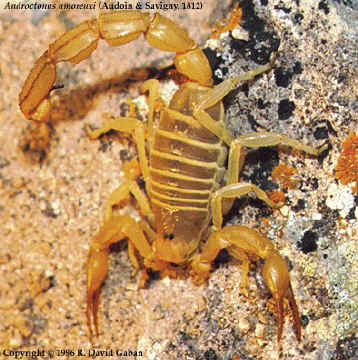
A.amoreuxi, photo by Dave Gaban
Differing from Androctonus australis, the terminal metasoma does not have the darker coloration and the metasoma is not as wide as A.australis.
LD50 : 0.75 (same value from Simard and Watt 1984, Habermehl
1981and Hassan 1984)
Apparently, the potency elucidated is similar.
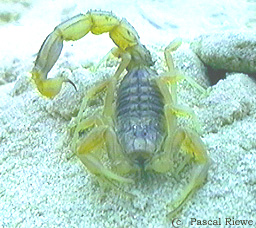 Photo of Buthus occitanus (tunetanus?) kindly provided by Pascal
Riewe Photo of Buthus occitanus (tunetanus?) kindly provided by Pascal
Riewe |
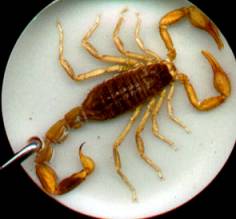 A keychain containing a Buthus sp within. |
This specimen is caught from Tunisia and represents well the genus Buthus. It is the species which has vastly different LD50 for its subspecies. The one is South France has much less potent venom. Needs no rocket scientist to which subspecies lives in France.
LD50: 0.9 for Buthus occitanus tunetanus, 4.15 for Buthus occitanus paris
Fat
tailscorpion, Parabuthus transvaalicus
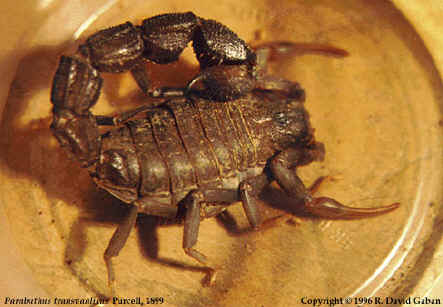
Photo by Dave Gaban.
Apparently a common scorpion on offer. Do not deserve a place here as very few death
iscaused by this species. It is placed here to allow comparision with A.bicolor
which look slightly similar. Difference is observed in coloration, body shape and texture.
An easier gauge is that this comes from South Africa while A.bicolor is more common
in North Africa.
Description extracted from Dave Gaban:
It is one of the largest buthid and can attain 4.5-5 inches (11.5-12.7cm). The pedipalp is
very slender and the metasoma very wide. Males has more bulbous and shorter chelae and are
smaller size with longer pectines. It is generally chocolate brown and is lighter at the
legs and pedipalp. Its telson is large and bulbous with granular bumps and reddish
setae.It comes from Botswana, South Africa, Rhodesia and Mozambique.
From Gaban and other sources:
This species together with Parabuthus villosus and several other Parabuthus
sp is capable of spraying aerosol of venom up to a distance of about 2 feet. Severe
pain and temporary blindness is generally experienced by victims and permanent damage
ispossible if not washed out immediately. It is strongly recommended for anyone in direct
exposure to Parabuthus spp to wear goggles. As the venom quantity it is capable of
injecting is quite high, it may be quite dangerous to handle. However, Dr Scott
Stockwell's first hand account, suggests none of the serious systemic toxic effect.
Parabuthus liosoma, photo by Carl
On name:
P.transvaalicus comes from a geopolitical and geographic region called
Transvaal in South Africa (Stockwell). Author of 'Arachnomania' herpertologist Phillipe
DeVosjoli seems to be the source of the commonly used name Parabuthus transvaalensisfor
this species. Even Gary A. Polis in highly acclaimed 'The Biology of Scorpion' and a
number of toxicology books uses P.transvaalensis. However, P.transvaalicus is
now more accepted than P.transvaalensis.
Dave Gaban, Dr Scott Stockwell and now Herbert Schiejok propose the use of P.transvaalicus
instead. Other wrong names which even reputable authors and herptiles dealers uses
includes P.transvallicus, P.transvallensis, P.transvalicus etc. These are not
recommended for use.
LD50: 4.25
Arizona
Bark Scorpion, Centruroides exilicauda
C.exilicauda doing promenade a deux, courtesy of Dave Gaban
Perhaps one of the most infamous species. It is previously known under many different
names. A sample is like Florida bark scorpion, Arizona deadly scorpion, Arizona
barkscorpion, sculptured scorpion etc. The previous scientific name is Centruroides
sculpturatus which till today is still widely used. Other scientific names referringto
the same species are Buthus exilicauda, Centrurus exilicauda, Centruroides
gertschi,Centruroides pallidicep and Centruroides zweifeli. This is an example
of how even scientific name can be so messed up. It is recommended that modern reference
to stickto Centruroides exilicauda to reduce the confusion.
During the 1940s-1960s, over 1000 deaths each year is attributed to this widespread
species though it may be untrue. Numerous older and supposedly objective scientific
studies I've read may have exaggerated the death caused by the species.
This is what spark a small research on my own ending with Dr Scott Stockwell strongly worded but highly enlightening insights with the more recent publications. No death from this species has been recorded in Arizona since 1968. The Arizona State University claims it to be the success of their anti venom but it is more probably due to less use of inappropriate treatments like injection of potent opioids. The use of this species as a'scapegoat' seems to arise since Stahnke (1928) who's researching on antivenom for this species label it as Arizona lethal scorpion. Even though, this species DO NOT strictly belongs here (it is not a deadly species), it deserves a mention for those still in doubt.
Articles and books I went through on this alone are WHO 1981 estimates, Biology of Scorpion(Polis,1990), Venomous amd poisonous animals (Habermehl,1981), Watt and Simard (1984), Merck manual, Medical entomology, Scorpion in Kentucky (LeeTownsend), Smith 1992, Scorpionism in Mexican (Mazotti and Bravo-Brecherelle with use of Mexico statistic board, Death register etc....till 1958) Most of the above suggest C.exilicauda to be 'deadly'
Dr Scott Stockwell quoted more recent articles like one by Dehesa-Davila & Possani (1994) which reflects stats up till 1990. No official death isattributed positively to C.exilicauda. Others like C.noxious, C.limpidus ssp,C.suffusus are implicated.
It is found in Southwest USA.
GENERAL ID:
A typical Centruroides. Body coloration and pattern has numerous variation and
is difficult to generalise. Grows to 2 and a half inch. More photos are available in Dr
Scott Stockwell's page.
LD50: 1.12-1.46 (1.12, Habermehl 1981)
Stripedbark
scorpion, Centruroides vittatus
C.vittatus eaing a small cricket, courtesy of Dave Gaban
The sting of this species in Texas is recently found to be worse symptomatically than that of C.exilicauda. However, death is very rare. It is very common in USA. It grows to about 2 inches. Not considered dangerous but Dr Scott Stockwell equated its sting to be equivalent of "a nail driven through the site of sting". Other physicians report similarly severe discomfort among patients being stung. It is not a aggressive scorpion and more pictures are scattered throughout my page.
It is interesting to note that many Centruroides sp. lives in colony. This is quite uncommon among scorpions and has equivalent in some Scorpionidae like Pandinus imperator. Intra specific cannibalism is reportedly quite low for these species considering the population density.
General ID: Any scorpion resembling the photos I've shown of C.vittatus deserves some respect
LD50: no figure
Yellow legged creeping scorpion, Opistopthalmus glabrifons

Photo kindly provided by Dave Gaban
Thus far, all the scorpions mentioned belongs to the family Buthidae. The above belongs to Scorpionidae and must come as a surprise to most. No deaths has been attributed to it but a research read by Dr Nils Bergman shows that O.glabrifons venom cause systemic neurologic symptoms in some victims. This generally means quite serious envenomation non-typical of Scorpionidae stings. It is one good example to ask anyone handling scorpions to exercise caution even in supposedly safe species. It occurs in South Africa
suppposed LD50 for Opistopthalmus spp : 600(Habermehl, 1981), 625 (Hassan, 1984)
Another Scorpionid definitely worthy of a place here is the Hemiscorpius lepturus. Many deaths, mainly of children, had been attributed to this species in Iran (ongoing research, Mr Matt Braunwalder). Permanent scarring and severe local damage has been reported after being stung by this species.
Some reports also quoted at least 23 deaths (9 adults) in India over 14 years due to stings of Asian giant forest scorpion, Heterometrus sp.. Heterometrus swammerdami is one of the largest Heterometrus sp. found in India. However,this genus is not usually known to have potent venom but once again care should be exercise handling any scorpion.

Mesobuthus gibbosus, courtesy of Alexandros Pagidas
About 20-35 species of scorpions is quoted by most authors to be medically significant. Of these, I have included here 25, 4 of which is not deserving of a place here. That puts my tally at 20. There are quite a few others especially subspecies not included. Also not all stated here are of equal danger to man and some are not considered lethal by some experts. Nevertheless, these species should be noted and avoided for beginners. Also, anyone who encounter the abovementioned scorpions should give it a respectful clearance to retreat.